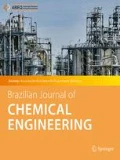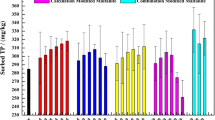Abstract
This paper aims to characterize a natural sediment from Bahía Blanca estuary (Argentina) as a new clay source and determine the catalytic capacity after its structural modification by an acid activation process. The acid treatment was performed by employing H2SO4 at different concentrations at 353 K and 60 min. The raw material and acid-activated samples were characterized by XRD, XRF, FTIR, N2 physisorption, TGA, SEM, EDX, potentiometric titration and pyridine adsorption monitored by FTIR. Moreover, the catalytic activity on lauric acid esterification with methanol was evaluated as a test reaction. From the structural characterization, it was determined that the material studied contains mainly Ca-montmorillonite, illite, albite and quartz. Likewise, the results obtained showed that the acid-treatment impacts the material characteristics, predominantly surface acidity and textural properties. Particularly, it was evidenced that the samples treated under medium acid activation conditions lead to an increase in acid site number and strength and specific surface area and consequently improve the catalytic activity. The results obtained evidenced that this low cost and widely available raw material presents an interesting mineralogical composition with a high clay mineral content. Additionally, the catalytic performance showed a good conversion in the test reaction regarding other heterogeneous catalysts. Hence, considering these results, this natural sediment merits further research on its purification and application.


Adapted from Gupta et al. (2013)]. a Original 2:1 clay mineral, b interlamellar cations are replaced by hydrated protons, c octahedral metals are leached from the structure, d hydrated silica is formed by the clay structure collapse






Similar content being viewed by others
References
Alvarez-Puebla RA, dos Santos DS Jr, Blanco C, Echeverria JC, Garrido JJ (2005) Particle and surface characterization of a natural illite and study of its copper retention. J Colloid Interface Sci 285(1):41–49
Alver BE, Dikmen G, Alver Ö (2016) Investigation of the influence of heat treatment on the structural properties of illite-rich clay mineral using FT-IR, 29Si MAS NMR, TG and DTA methods. Anadolu Univ J Sci Technol-A-Appl Sci Eng 17(5):823–829
Angeletti S, Cervellini PM, Lescano L (2018) Burrowing activity of the Neohelice granulata crab (Brachyura, Varunidae) in southwest Atlantic intertidal areas. Cienc Mar 44(3):155–167
Bergaya F, Lagaly G (eds) (2013) Handbook of clay science, 2nd edn. Elsevier, Amsterdam
Brantley SL, Mellott NP (2000) Surface area and porosity of primary silicate minerals. Am Mineral 85(11–12):1767–1783
Carretero MI, Pozo M (2009) Clay and non-clay minerals in the pharmaceutical industry: part I. Excipients and medical applications. Appl Clay Sci 46(1):73–80
Castro CS, Júnior LCFG, Assaf JM (2014) The enhanced activity of Ca/MgAl mixed oxide for transesterification. Fuel Process Technol 125:73–78
Choi J, Han Y, Kim D, Park S, Park J, Park J, Kim H (2014) Synthesis and characterization of mesoporous silica from anorthite-clay mineral: role of mechanical activation. Mater Trans JIM 55(12):1895–1899
Cid R, Pecchi G (1985) Potentiometric method for determining the number and relative strength of acid sites in colored catalysts. Appl Catal 14(1–3):15–21
Firestone D (ed) (1998) Official methods and recommended practices of the American oil chemists’ society, 5th edn. AOCS Press, Champaign
Flessner U, Jones DJ, Rozière J, Zajac J, Storaro L, Lenarda M, Pavan M, Jiménez-López A, Rodriguez-Castellon E, Trombetta M, Busca G (2001) A study of the surface acidity of acid-treated montmorillonite clay catalysts. J Mol Catal A 168(1–2):247–256
González JDDL, Saenz AR, Reinoso FR, Calahorro CV, Herrera LZ (1981) Activación de una sepiolita con disoluciones diluidas de NO3H y posteriores tratamientos termicos: I. Estudio de la superficie específica. Clay Miner 16(1):103–113
Gupta VG, Tuohy M, Kubicek CP, Saddler J, Xu F (eds) (2013) Bioenergy research: advances and applications, 1st edn. Elsevier, Oxford
Hart MP, Brown DR (2004) Surface acidities and catalytic activities of acid-activated clays. J Mol Catal A 212(1–2):315–321
Hsiao YH, La Plante EC, Krishnan NA, Le Pape Y, Neithalath N, Bauchy M, Sant G (2017) Effects of irradiation on albite’s chemical durability. J Phys Chem A 121(41):7835–7845
Jeenpadiphat S, Tungasmita DN (2014) Esterification of oleic acid and high acid content palm oil over an acid-activated bentonite catalyst. Appl Clay Sci 87:272–277
Jozefaciuk G, Bowanko G (2002) Effect of acid and alkali treatments on surface areas and adsorption energies of selected minerals. Clays Clay Miner 50(6):771–783
Komadel P (2003) Chemically modified smectites. Clay Miner 38(1):127–138
Komadel P (2016) Acid activated clays: materials in continuous demand. Appl Clay Sci 131:84–99
Krupskaya VV, Zakusin SV, Tyupina EA, Dorzhieva OV, Zhukhlistov AP, Belousov PE, Timofeeva MN (2017) Experimental study of montmorillonite structure and transformation of its properties under treatment with inorganic acid solutions. Minerals 7(4):49
Kumar P, Jasra RV, Bhat TS (1995) Evolution of porosity and surface acidity in montmorillonite clay on acid activation. Ind Eng Chem Res 34(4):1440–1448
Lenarda M, Storaro L, Talon A, Moretti E, Riello P (2007) Solid acid catalysts from clays: preparation of mesoporous catalysts by chemical activation of metakaolin under acid conditions. J Colloid Interface Sci 311(2):537–543
Long YD, Fang Z, Su TC, Yang Q (2014) Co-production of biodiesel and hydrogen from rapeseed and Jatropha oils with sodium silicate and Ni catalysts. Appl Energy 113:1819–1825
Madejová J, Komadel P (2001) Baseline studies of the clay minerals society source clays: infrared methods. Clays Clay Miner 49(5):410–432
McKillop A, Young DW (1979) Organic synthesis using supported reagents-part I. Synthesis 1979(06):401–422
Mendioroz S, Pajares JA, Bentino I, Pesquera C, Gozalez F, Blanco C (1987) Texture evolution of Montmorillonite under progressive acid treatment: Change from H3 to H2 type of hysteresis. Langmuir 3(5):676–681
Oikonomopoulos IK, Perraki M, Tougiannidis N, Perraki T, Kasper HU, Gurk M (2015) Clays from Neogene Achlada lignite deposits in Florina basin (Western Macedonia, N. Greece): a prospective resource for the ceramics industry. Appl Clay Sci 103:1–9
Olephen HV, Fripiat JJ (eds) (1979) Data handbook for clay materials and other, 1st edn. Pergamon Press, Oxford
Panda AK, Mishra BG, Mishra DK, Singh RK (2010) Effect of sulphuric acid treatment on the physico-chemical characteristics of kaolin clay. Colloids Surf A Physicochem Eng Asp 363(1–3):98–104
Pentrák M, Madejová J, Komadel P (2010) Effect of chemical composition and swelling on acid dissolution of 2:1 clay minerals. Philos Mag 90(17–18):2387–2397
Pushpaletha P, Rugmini S, Lalithambika M (2005) Correlation between surface properties and catalytic activity of clay catalysts. Appl Clay Sci 30(3–4):141–153
Rezende MJC, Pinto AC (2016) Esterification of fatty acids using acid-activated Brazilian smectite natural clay as a catalyst. Renew Energy 92:171–177
Rhodes CN, Brown DR (1993) Surface properties and porosities of silica and acid-treated montmorillonite catalyst supports: influence on activities of supported ZnCl2 alkylation catalysts. J Chem Soc Faraday Trans 89(9):1387–1391
Rhodes CN, Brown DR (1994) Catalytic activity of acid-treated montmorillonite in polar and non-polar reaction media. Catal Lett 24(3–4):285–291
Schaper UA (1981) Die Einführung der O-Ethoxymethyl-Gruppe zum Schutz der Hydroxy-Gruppe in Alkoholen und Phenolen. Synthesis 10:794–796
Seyama H, Kinoshita K, Soma M (2002) Surface alteration of plagioclase during acid dissolution. Surf Interface Anal 34(1):289–292
Sidorenko AY, Sen’kov GM, Agabekov VE (2014) Effect of acid treatment on the composition and structure of a natural aluminosilicate and on its catalytic properties in α-pinene isomerization. Catal Ind 6(2):94–104
Sidorenko AY, Kravtsova AV, Aho A, Heinmaa I, Kuznetsova TF, Murzin DY, Agabekov VE (2018) Catalytic isomerization of α-pinene oxide in the presence of acid-modified clays. Mol Catal 448:18–29
Sieskind O, Albrecht P (1985) Efficient synthesis of rearranged cholest-13 (17)-enes catalysed by montmorillonite-clay. Tetrahedron Lett 26(17):2135–2136
Sing KS (1985) Reporting physisorption data for gas/solid systems with special reference to the determination of surface area and porosity (Recommendations 1984). Pure Appl Chem 57(4):603–619
Srasra E, Bergaya F, Fripiat JJ (1994) Infrared spectroscopy study of tetrahedral and octahedral substitutions in an interstratified illite-smectite clay. Clays Clay Miner 42(3):237–241
Steudel A, Batenburg LF, Fischer HR, Weidler PG, Emmerich K (2009a) Alteration of non-swelling clay minerals and magadiite by acid activation. Appl Clay Sci 44(1–2):95–104
Steudel A, Batenburg LF, Fischer HR, Weidler PG, Emmerich K (2009b) Alteration of swelling clay minerals by acid activation. Appl Clay Sci 44(1–2):105–115
Su CH (2013) Recoverable and reusable hydrochloric acid used as a homogeneous catalyst for biodiesel production. Appl Energy 104:503–509
Temuujin J, Jadambaa T, Burmaa G, Erdenechimeg S, Amarsanaa J, MacKenzie KJD (2004) Characterisation of acid activated montmorillonite clay from Tuulant (Mongolia). Ceram Int 30(2):251–255
Theodosoglou E, Koroneos A, Soldatos T, Zorba T, Paraskevopoulos KM (2010) Comparative Fourier transform infrared and X-ray powder diffraction analysis of naturally occurred K-feldspars. Bull Geol Soc Greece 43(5):2752–2761
Tyagi B, Chudasama CD, Jasra RV (2006) Determination of structural modification in acid activated montmorillonite clay by FT-IR spectroscopy. Spectrochim Acta Part A 64(2):273–278
Wang TH, Liu TY, Wu DC, Li MH, Chen JR, Teng SP (2010) Performance of phosphoric acid activated montmorillonite as buffer materials for radioactive waste repository. J Hazard Mater 173(1–3):335–342
Yahaya S, Jikan SS, Badarulzaman NA, Adamu AD (2017) Effects of acid treatment on the SEM-EDX characteristics of Kaolin clay. Path Sci 3(9):4001–4005
Zatta L, da Costa Gardolinski JEF, Wypych F (2011) Raw halloysite as reusable heterogeneous catalyst for esterification of lauric acid. Appl Clay Sci 51(1–2):165–169
Zatta L, Ramos LP, Wypych F (2012) Acid activated montmorillonite as catalysts in methyl esterification reactions of lauric acid. J Oleo Sci 61(9):497–504
Zatta L, Ramos LP, Wypych F (2013) Acid-activated montmorillonites as heterogeneous catalysts for the esterification of lauric acid acid with methanol. Appl Clay Sci 80–81:236–244
Acknowledgements
The authors are thankful to the Consejo Nacional de Investigaciones Científicas y Técnicas (National Council for Scientific and Technological Research, CONICET, Argentina) and the Agencia Nacional de Promoción Científica y Tecnológica (National Agency of Scientific and Technological Promotion, ANPCyT, Argentina)-PICT 2014-3211 for the financial support.
Author information
Authors and Affiliations
Corresponding author
Additional information
Publisher's Note
Springer Nature remains neutral with regard to jurisdictional claims in published maps and institutional affiliations.
Electronic supplementary material
Below is the link to the electronic supplementary material.
Rights and permissions
About this article
Cite this article
Reinoso, D.M., Angeletti, S., Cervellini, P.M. et al. Study of structural properties of acid-treated natural sediment and its application as a sustainable catalyst. Braz. J. Chem. Eng. 37, 679–690 (2020). https://doi.org/10.1007/s43153-020-00066-2
Received:
Revised:
Accepted:
Published:
Issue Date:
DOI: https://doi.org/10.1007/s43153-020-00066-2




